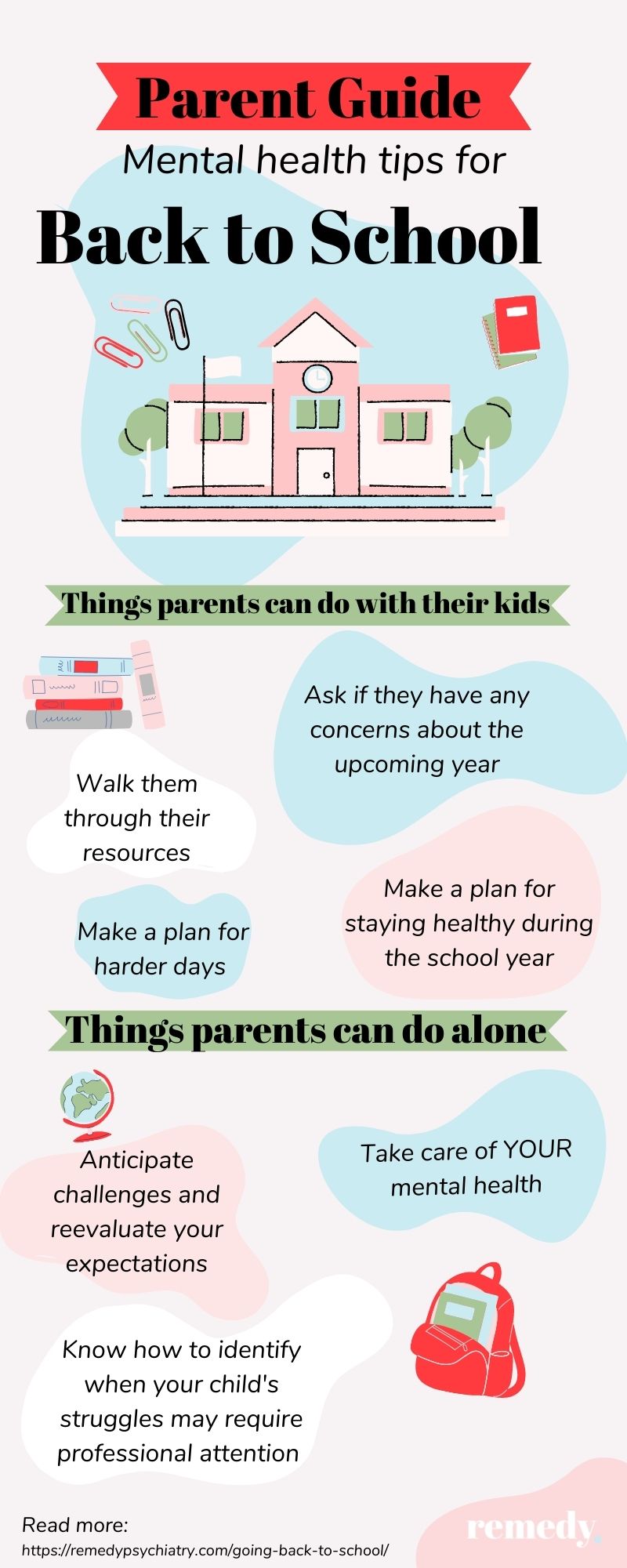For most kids, the thought of going back to school brings up a host of conflicting thoughts and emotions. Kids may be excited to see old friends again, nervous about facing their classroom’s social hierarchy, and so much more. One particularly unique set of challenges facing incoming classes of students are those related to the pandemic. Uncertainty, fear, loss of normalcy, disruption of routine, reduced peer interaction, loneliness, lack of structure, and grief or loss are just a few of the heavy issues every child returning to school this fall has dealt with recently. Though the degree of impact may vary from student to student, it is safe to assume the best course of action is to provide children and adolescents the support they need to succeed in school – an environment that posed its challenges long before the pandemic.
If you are concerned about your child’s ability to readjust to the school environment, schedule, etc., you are not alone and there are several ways to help prepare them. In this blog, we will discuss why tending to your child’s mental health is important and the concrete ways you can help prepare your child mentally for going back to school.
Mental Illness in Children and Adolescents
With all the mature themes of introspection, accountability, and trauma that surround mental health, it is easy to associate mental health issues with adults and overlook their prevalence in children and adolescents. In reality, 1 in 5 youth ages 9-17 currently suffer from a diagnosable mental illness that causes a small to moderate degree of impairment – 1 in 10 experience severe impairment. Also, one half of all serious adult psychiatric disorders begin by age 14, but it typically takes a person 6 to 23 years to seek and receive treatment for their mental health concern.
The most common mental health concerns to affect children and adolescents are anxiety (9.4%) and attention deficit/hyperactivity disorder (ADHD) (9.8%). Below are just a few sobering figures that demonstrate the real prevalence of mental health concerns in children and adolescents:
- 1 in 6 children aged 2-8 years has a mental, behavioral, or developmental disorder.
- According to Mental Health America’s data for 2022, approximately 15.08% of youth (age 12-17) reported suffering from at least one major depressive episode (MDE) in the past year – a number which increased by 306,000 (1.24%) from last year’s dataset.
- The same MHA data showed that 4.8% of youth reported having a substance use disorder – 1.64% involving alcohol use. 3.16% involving illicit drug use.
- According to data from the Center for Disease Control and Prevention (CDC), about 3 in 4 children with depression also experience anxiety, and nearly 1 in 2 also experience behavior problems.
- Approximately 60% of youth with major depression do not receive any mental health treatment.
- Suicide is the 3rd leading cause of death in adolescents.
What Parents/Caregivers Can Do
The importance of being proactive about the youth’s mental health cannot be understated. Though school can have a profound impact on a young person’s mental health, their home environment and support system can fortify them with resources they need to stay mentally healthy during the school year. Here are a few methods of helping our young people as they head to school:
With the kids
- Ask them if they have any concerns about the upcoming school year. There are concerns you can imagine your child might be having, and then there are those that specifically surround their generation’s circumstances which you may not have considered yet. Whether their worries involve navigating social hierarchies, managing a heavy workload, contracting/spreading illness, or active shooter events, your child’s worries have the potential to negatively impact their academic life. Different concerns may require different approaches and/or resources, so it is important to receive clear confirmation of what is troubling them instead of assuming you know all of their worries.
- Walk them through their resources. Does your child know who they can turn to in the event that they are being bullied? Or if they are feeling overwhelmingly anxious? Inquire about the resources available to students at your child’s school and talk to your child about where they can go in certain situations they may face in the future. If you believe your child may require more proactive support, make sure to become familiar with their school’s Individualized Education Programs (IEPs). These formal programs ensure a detailed learning plan is created based on your child’s disability, goals, and required academic services.
- Encourage them to make a plan for staying healthy during the school year. Sometimes maintaining your physical health feels more obvious than maintaining your mental health, but they require equal amounts of effort. To avoid forgetting to implement practices in everyday life that help keep you mentally healthy, help your children make a list of those practices before the rush of school takes precedence. Examples might be practicing meditation or deep breathing for 10 minutes every night, going outside for at least 30 minutes a day, avoiding foods that make them crash after eating them, exercising at least a few times a week, limiting screen time, etc.
- Help them make a protocol for harder days. No matter how many proactive steps you and your child take to fortify their mental health, some days are going to be harder than others and recognizing that means you can plan for the event. In the middle of experiencing a bad day’s brain fog, it can be hard to remember the steps necessary to regulate one’s thoughts and emotions. Not only does creating a protocol for harder days make their coping more streamlined, it can also provide them a greater sense of agency in regards to their emotional well-being. Examples of activities that can be added to such a protocol include immediately taking a shower, listening to a premade playlist of songs that they enjoy, practicing deep breathing, or going through a Socratic questions or Decatastrophizing worksheet. Another useful tool that could be implemented in a hard day protocol is a premade basket filled with things that can help your child cope with a hard day. This could include objects that stimulate each of their senses, such as a favorite scented lotion, a yummy snack, a kaleidoscope, headphones for brown noise, and a cold pack. Focusing on the individual sensory experiences these objects provide is a great way for your child to practice mindfulness. Download our back to school parent tips here.
Parents alone
- Take care of your mental health. Even if a child does not know what led to the “negative” emotions their parent is exhibiting, they are fully aware, and susceptible, to the tension, anxiety, confusion, frustration, or anger they are experiencing. The influence of those in one’s environment stands true for children and adults alike, but children are typically not as equipped to separate themselves from their parent’s emotions, especially if a parent is particularly agitated because of their mood and taking it out on their child. Tending to your mental health not only aids in providing a healthy home environment that helps children succeed at school, it also sets a precedent for how “negative” emotions ought to be handled. By being honest about your thoughts and emotions (within reason), you can lead by example in how you deal with them by modeling healthy behaviors and coping skills.
- Anticipate challenges and reevaluate your expectations. The start of the school year means a lot of changes for your child. A different schedule, heavier workload, less time with friends and family – these are just a few of the factors that your child will be dealing with, but as mentioned before, children entering school this fall have an additional new set of challenges as a result of living through a pandemic. Your children may experience mixed emotions about integrating back into a classroom, letting go of the benefits of online learning, or even feeling like 2 years of changes and challenges has made them different in some way. Whatever the case, anticipating differences in your child’s typical mood or behavior – especially in the first few weeks of school – can be helpful in preventing any unnecessary tense moments. There will likely be moments coming up when your child is feeling more overwhelmed than before and reevaluating your expectations of them can demonstrate the respect and consideration they can return in kind.
- Know how to identify when your child’s struggles may require professional attention. Though parents should anticipate changes in their child’s mood and behavior as they approach the start of school, part of being proactive about a child’s mental health is knowing the signs of something bigger. Early detection and treatment is pivotal in the prognosis of mental illness, so knowing the common signs and symptoms of mental illness can make your child’s mental health journey easier in the short- and long-term. Some signs and symptoms you should look for are:
- Brain fog (i.e. difficulty with concentration or memory)
- Changes in appetite
- Frequently feeling sad, hopeless, worthless
- Apathy or loss of interest in things they used to enjoy
- Excessive worry or panic episodes
- Frequent irritability or restlessness
- Sleep disturbances, such as difficulty falling or staying asleep
- Anger outbursts
- Social isolation
- Onset of repeated behavioral rituals
- Changes in how they dress – if your child is wearing long pants and sleeves in hot weather, it could be a sign of attempting to cover up self harm
- Indirect or direct threats of suicide








